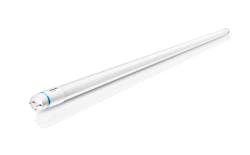CALiPER Snapshot Finds TLEDs’ Popularity Exceeds Their Performance Edge
Linear LED lamps designed to replace fluorescent tubes in countless commercial, industrial and residential troffer applications worldwide make up one of the fastest-growing segments of the LED lighting market, the U.S. Department of Energy (DOE) found in a recent CALiPER Snapshot report. The lamps, known as TLEDs, now make up more than 10% of active products and more than 50% of active lamps listed in the DOE’s LED Lighting Facts database. But based on data in Lighting Facts, researchers found that this wave of popularity doesn’t mean TLEDs are the preferable technology.
“Their rise to prominence is indisputable, but TLEDs are not necessarily a clear favorite when evaluating performance,” the report said in its concluding discussion.
The report looks at TLEDs across their variations including those that can operate directly on a fluorescent ballast, those with an integrated driver, those with an external driver and hybrid models. While these differences matter greatly when specifying and installing the lamps, DOE found very little difference in photometric performance based on those parameters. TLEDs have the largest range of luminous efficacy in the Lighting Facts database: some TLEDs are at the vanguard of LED efficiency and others are less efficacious than the linear fluorescent lamps they typically replace.
Although TLEDs overall consistently draw less power than the lamps they are intended to replace and their more directional emissions allow them to provide equal illuminance at the work plane but that directionality can change the appearance of the luminaire and the distribution of lighting within a space.
“At first glance, TLEDs may appear superior, with higher efficacy and likely a lower product cost and installation cost. However, accounting for factors such as luminaire efficiency and the remaining life of existing fluorescent ballasts (if they are to be reused) may tip the balance against TLEDs in some scenarios,” the report said.
Given the profusion of TLED models on the market, there is a wide range of performance variation, even when examining only basic attributes. “When evaluating TLEDs, it is critical to examine the expected performance of the complete lamp and luminaire system, understand the complexities of installation, and be cautious in considering long-term performance,” the report concludes.
